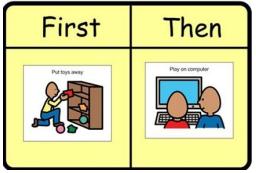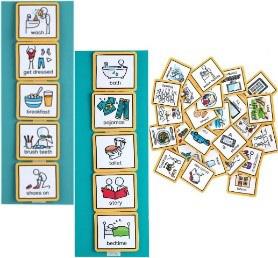Transition Tips Resource Package



NOTE: This package consists of strategies which may or may not assist in responding to behaviour. It is provided for informational purposes only and is not a substitute for professional advice or treatment from a qualified behaviour clinician.

A transition refers to changing from one activity to another (e.g., iPad time to laundry).
A transition can also be moving from a highly-preferred activity to a lesspreferred one (e.g., a fun 1:1 outing to unstructured time at home).
• Give extra support for any disruption to activities, the setting, or a routine
• Can be used before a change occurs, during, and/or after a change

• Might be presented visually, verbally or auditorily
• Increase predictability and understanding of the “unknown”
• Create more positive routines around transitions
• Can be used across settings to promote consistency
1. Reduce transition times
2. Improve cooperative and decrease offtask behaviours
3. Less need for caregiver reminders
4. Community outings become easier
Changes to one’s routine or schedule might happen!
Planned J or unplanned L DO
• Think of changes that may affect a routine ...
• Plan ahead, be prepared and be consistent!
 Hume, K. (2022). Transition time: Helping individuals on the autism spectrum move successfully from one activity to another. Indiana Institute on Disability and Community.
Hume, K. (2022). Transition time: Helping individuals on the autism spectrum move successfully from one activity to another. Indiana Institute on Disability and Community.
If changes to routine are difficult, plan the individual’s day to include the least amount of unnecessary transitions as possible. This provides structure by outlining a series of activities or events, also predictability with what is coming up next. By depicting a visual representation of their day, you can increase independence by having an individual look to the visual schedule and move from one activity to the next, with less prompting from caregivers.
Use of “First X, Then Y” language, paired with corresponding visual symbols can explain the expectations within a sequence of events. This prepares for an upcoming transition by presenting the less-preferred activity, followed by the highly-preferred activity – as “First” communicates the task to complete, “Then” shares the preferred activity afterwards. Ensure that the “then” component is something reinforcing in order to increase motivation to transition.
It may be helpful for individuals to see and hear how much time remains in an activity before they will be expected to transition. Flicking the lights or use of hand-signals offer a warning a transition is to occur. Use of visual cues such as time-timers, counting on fingers or showing cue cards provide a countdown to any activity change. Verbal prompts (e.g., “1 more minute left in class”) or auditory alerts (e.g., egg timer, bell/chimes, alarms) can also mark that an activity will end.
A transition object is any item that can be carried by an individual, during a change in activity or routine. This can be an object to shift the individual’s attention from the change (e.g., a fidget toy) or can soothe/regulate (e.g., a sensory object) during disrupted routines. This object could also be functional items that are related to the upcoming transition, used as a “prop” (e.g., envelopes to deliver from workplace to home/lunchbox to carry from bus to school).
Build in short and natural breaks throughout the day. Teach the individual to request for a “delay” or communicate needing a “break” if they are not ready to transition yet, instead of engaging in non-cooperative behaviour.



When you see an individual about to engage in off-task or non-cooperative behaviour during a transition, intervene in a supportive way. First, redirect the individual to something similar, but more appropriate to do - like answering a question or completing a movement (e.g., “Where are we going next?”, “Let’s walk together”, “Can you help me deliver this item?”) Second, provide praise during the redirection – label the appropriate behaviours you see (e.g., “Thanks for cleaning up your toys”, “nice walking”, “good following me”). Third, if possible and appropriate, join in on the upcoming activity to make it appealing.
